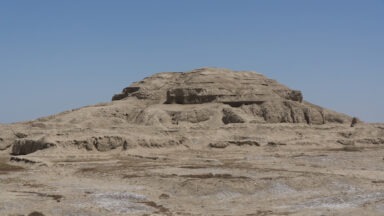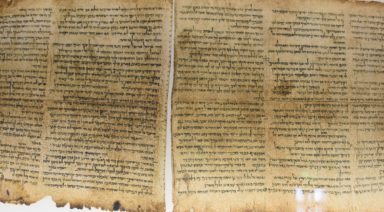Do These Legendary Tombs Reveal the Presence of Giants in Sardinia?

Perhaps few lands, ancient or modern, are as attractive as Italy — for its people, rolling landscapes, Mediterranean coast, and rich historical allure. We can add to this list an emerging archaeological phenomenon in Sardinia. On this island off the coast of Italy, lies an ancient site where skeletal remains of giants have been uncovered, defying academic conclusions about the land’s earliest inhabitants.
If you take a ferry, Sardinia is situated five hours West of mainland Italy, and is home to a persistent theory that giants may have roamed the land. Travel guides suggest that much of the island’s prehistoric past has been preserved, mainly because Sardinia features a relatively unpopulated countryside, and many areas where people once lived have long been abandoned. Human occupation is traceable steadily throughout the Upper Paleolithic, Mesolithic, Neolithic, Calcolithic, Bronze, and Iron ages.
While early Sardinians left behind significant contributions of ancient pottery and megalithic statues crafted out of large, heavy, and enduring stone, perhaps the most startling finds are those said to be of Sardinian giants and include bone and teeth fragments. The site in question is in Coddu Vecchiu, in a place that locals and archaeologists alike refer to as Tomba dei Giganti — the tomb of the giants. It was constructed during the Bronze Age (3300-700 BC) by the Nuragic civilization as a public tomb, in an area where many were buried.
Located on a hillside peppered with vineyards, the giants’ tombs of Coddu Vecchiu are introduced through the doorway of a central stele (an upright stone slab or column serving as a gravestone), which was believed to serve as a barrier between the physical world and the afterlife. In the stone forecourt of the compound are eleven granite stones, arranged in a semicircle measuring about 40 feet across.
It has been hypothesized that the semicircular arrangement of the stones may have been an attempt to harness telluric currents of the granite for rejuvenating purposes. Author of Mysterious Places in Italy, Isabella Dalla Vecchia, wrote that telluric energy and magnetic forces flowing under the Earth’s crust and is part of what makes planet Earth a living organism. Dalla Vecchia wrote, “Man, a creature of Mother Earth, is able to interact with and become very sensitive to these movements. Men absorb them unconsciously in particular situations.” Additionally, she explained, a large stone slab with a small doorway is believed to connect the gravesite with the outside world. The opening symbolizes the union between this world and the afterworld. Offerings were deposited on a large bench at the base of the tomb.
Legends vs. Modern Science
According to legend, Sardinia was once home to a race of giants. Those who support this theory point to the massive size of some of the stones used on the burial grounds. On the other hand, archaeologists argue that only the tombs are giant, but those buried at the site were normal-sized humans. Perhaps equally mysterious aspects of the archaeological site are traces of rituals, the existence of powerful sources of natural energy, and how the megaliths are related to the heavens. Many tombs of giants are oriented toward the Taurus’ constellation and point to the brightest star, Aldebaran. And on the days of the Equinoxes, the light of the rising sun enters directly into the tomb corridor through a small opening on the stele.
The Story Unfolds in The New Season of Open Minds
Researchers for Ancient Origins noted that the giants’ graves “may provide us with more questions than answers. While they give an interesting insight into the burial rituals of ancient civilizations, they do not provide much information beyond the physical structure of the tombs and the fact that they were used for burial purposes. With religious and spiritual beliefs far different during ancient times than today, it’s likely ancient burial rituals were very different from what we currently know today. There was likely much focus on safely making it to the afterlife, and ensuring a smooth transition from a physical presence on Earth, to a spiritual presence beyond Earth, and possibly a reincarnation into a new life.” However, Gaia’s preeminent documentary host, Regina Meredith, may have more to offer on this subject.
As part of Evidence of Giants in Sardinia, authors Paola Harris (“UFOs: All The Above…and Beyond”) and Freddy Silva (“The Missing Lands”) look into legendary stories passed along through generations. The show notes, “All across the island we find thousands of stone structures, constructed hundreds of thousands of years ago, by a civilization lost to history…” In the video exposé, Meredith and her team explore ancient ruins that seem obviously too large for average-size human beings, while examining bone remnants of gigantic proportions. Additionally, they explore the forbidden history of the lost giants of Atlantis who may have settled in Sardinia after the great deluge.
Meredith’s interview with lifelong Sardinian resident Luigi Mucas, author of The Giants of Sardinia, has revealed that the people of the island have known about the presence of giants for generations. It is nearly impossible not to be aware of this history simply because bones have been found all over the island by locals going about their lives. As a little boy, Mucas said at family gatherings, there were stories of how his “ancestors came from a line of giants.” Mucas believes, based on the testimonies of generations of family members, that his people came from Atlantis and his people are the remnants of that civilization.
With strong reticence by modern archaeologists to entertain the existence of giants as part of human history on Earth, the Tombs of the Giants sites in Sardinia will continue to be a mystery that challenges the mainstream narrative. However, as Paola Harris explains, if you talk to the townspeople who act as firsthand witnesses, regardless of the official story coming from archaeology, “you’ll get the real truth.” And this truth, supported by evidence of bone fragments scattered all over Sardinia, discovered by modern-day inhabitants, is that a race of giants had once roamed this island in the Mediterranean.
Google Earth Image Shows Massive Alien Face In Antarctica

Millions are familiar with the face on the surface of Mars photographed in the red planet’s Cydonia region, but official explanations leave much to be desired and many wondering whether if it’s an artifact from an ancient civilization. But now there is a new face to ponder — one revealed from the melting ice of our planet’s frozen South. What’s being referred to as the “Antarctica Face” is causing quite a commotion among UFO hunters, skeptics, and scientists.
Antarctica Aliens or the Remnants of an Ancient Civilization?
The alien face of Antarctica is a sight to behold. It was discovered by Blake and Brett Cousins, who operate the YouTube channel “Third Phase Of Moon.” The pair has become extraordinarily successful as UFO hunters who frequently scan Google Earth for alien images captured from outer space. The brothers have amassed an impressive following over the years with their videos and commentary on UFO sightings and other strange phenomena, that is also reflected on their Facebook page boasting more than 750,000 followers. As of the first week of September 2019, their video on the Antarctica face alone (originally published on August 20, 2019) already received more than 350,000 views.
The Cousins’ mission, according to their Facebook description, is “to bring unfiltered video, messages & research in the field of ufology directly to the public!” The video of the Antarctica Face is certain to bolster their success and fan base, as well as bring attention to what is already a growing and well-established center of speculation.
In the Cousins’ video of the strange satellite images, Blake states, “It appears to be a massive, ancient structure of some kind of face that is being revealed for the first time on Google Earth.”




































